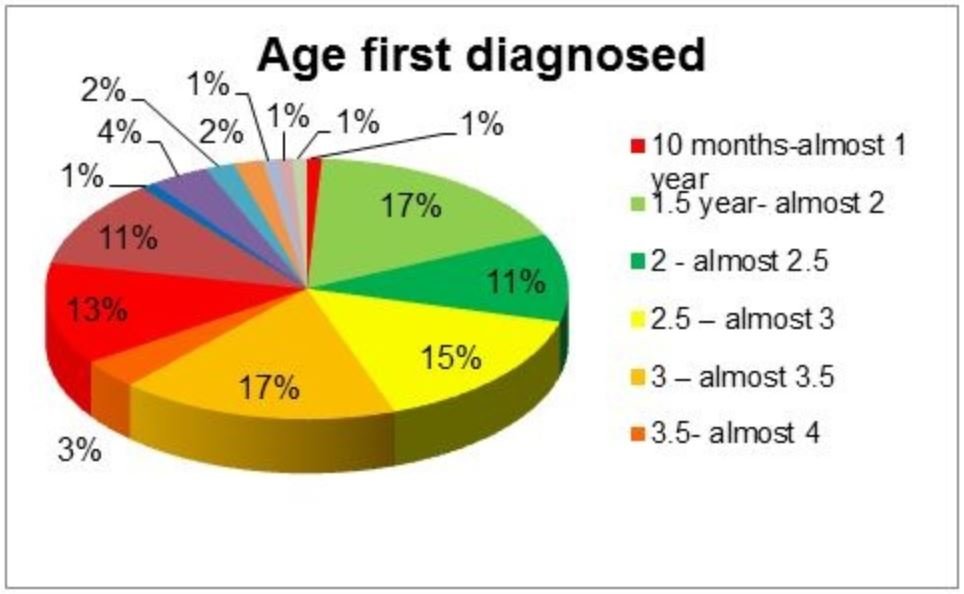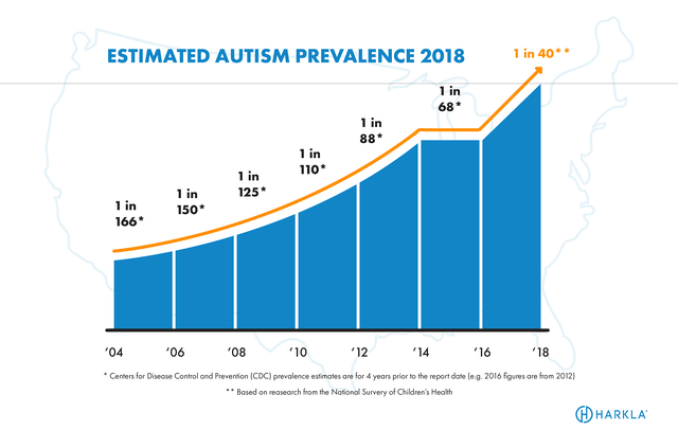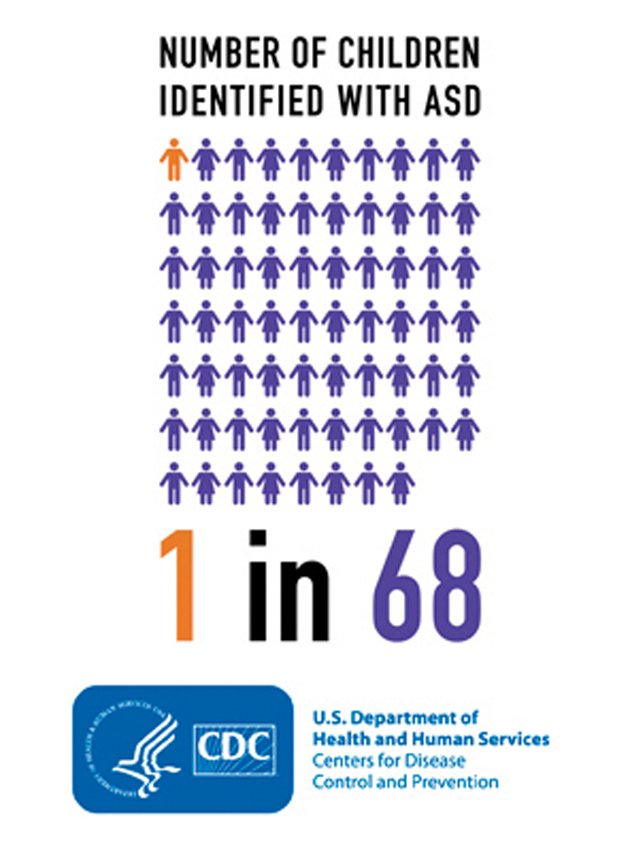How Many Children Are Misdiagnosed With Autism The Rates Continue To Rise
An autism diagnosis can be a frustrating thing for a parent to hear. But perhaps equally frustrating is the opposite: a reversal of that diagnosis. It’s long been speculated that some children are misdiagnosed with autism, and according to a study by the Centers for Disease Control and Prevention’s National Center for Health Statistics, roughly 13 percent of children previously diagnosed with autism spectrum disorder eventually lose their diagnosis, though the causes aren’t entirely clear.
The study, the first large-scale one of its kind, compared about 1,600 children aged 6â17âyears who had, at one time, been diagnosed with autism spectrum disorder. When the parents of the 13 percent who were no longer diagnosed with ASD were surveyed on the diagnosis reversal, 74 percent reported that they believed it was due to new information, suggesting that the children were initially misdiagnosed. Children with a reversed diagnosis were also found to be less likely to have had parents with early concerns about their symptoms, and less likely to have been diagnosed by a specialist.
So who exactly is diagnosing these kids whose parents were never even concerned in the first place? According to CNN, the fault may lie with current screening guidelines, which encourage non-specialist pediatricians to screen all children for ASD, regardless of symptoms.
Is Autism An Epidemic
Before discussing whether these numbers suggest an epidemic, its necessary to understand why autism statistics have increased. An epidemic is a spike in the rate of new cases. However, its unclear whether the prevalence of autism has really increased or if its just an increase in diagnoses.
Chris Abildgaard, LPC, a writer for Autism Parenting Magazine explains that there is an increase in identified cases of autism due to, expanding the definition from autism to autism spectrum disorder increasing knowledge of the disorder by professionals, which leads to an increase in better and earlier diagnoses more consistency by CDCs Autism and Developmental Disabilities Monitoring Network in the method used to identify cases an actual increase in the rate of children being born with the disorder.
Autism Society Of America
The Autism Society is the nations leading grassroots autism organization and exists to improve the lives of all affected by autism. Annually, the Autism Society and its nearly 80 local affiliates served more than 620,000 individuals impacted by autism through education, advocating for appropriate services for individuals across the lifespan, information and referral services, support, and providing community inclusion and acceptance at the national, state and local levels. Each April, we celebrate National Autism Awareness Month to spread awareness, promote acceptance, and ignite change. Learn more atwww.autism-society.org, or visit our NAAM website, autismawarenessmonth.org.
Read Also: What Is The Life Expectancy Of People With Autism
Around 54 Million Adults In The Us Are Autistic
As many as 5,437,988 people in the US, or 2.21% of the population, are autistic. Whats more, autism statistics by state reveal that the highest number of autistic adults resides in Florida , New York , Texas , and California . The lowest number of autistic adults has been recorded in Louisiana, autism rates by state indicate.
Stuttering Treatment For Those With Asd And Stuttering

The treatment for stuttering depends on the needs of the client, which is especially true in the case of those with ASDs. Stuttering further impacts communication and social skills of those with ASD. Therefore, therapy is crucial. Since self-monitoring and social interaction can be incredibly difficult for those with ASD, therapists often focus on fluency tools during social interactions.
Read Also: Diagnose My Child Symptoms
Autism Statistics Worldwide Reveal That One In 160 Children Is Autistic
While some people are diagnosed in childhood, others get proper diagnoses much later. Note that the disorder affects people differentlysome autistic people can live independently, while others require more support or life-long care. Whats more, autistic people and their families might incur considerable expenses as access to much-needed services is still inadequate in many places.
What Data Sources Were Used To Collect Data
NASS data are collected from a variety of sources, namely from education, social services and health sectors. The data source for each PT was identified through the environmental scans conducted from 2011 to 2015. Figure 2 identifies the PT ASD data sources from the participating regions for NASS.
Figure 2 – Provinces and territories by ASD data source for NASS, 2015
Figure 2 – Text description
Figure 2 illustrates the data sources of each of the 13 provinces and territories using a doughnut figure that has been colour coded to represent sources for each location. Five provinces use education data including: New Brunswick, Nova Scotia, Newfoundland and Labrador, and Yukon. Quebec uses Health Services data. British Columbia uses social services data. Prince Edward Island uses all data sources combined. The six remaining provinces and territories are under review for their data sources including: Northwest Territories, Nunavut, Ontario, Alberta, Saskatchewan, and Manitoba.
Also Check: Adhd Aspergers Comorbidity
Over 50% Of Autistic Children Are Either Overweight Or Are At Risk For Being Overweight
Autism awareness facts uncover that autistic people are more likely to be obese. Namely, 19% of autistic children are obese, and 36% are at risk of being overweight. That, in turn, puts children at increased risk for other health problemscardiovascular disease, diabetes, bone and joint problems, and depression.
Will Diagnoses Of Autism Continue To Increase
There is no way to know for sure if autism rates will continue to rise. As diagnostic criteria evolve, it could lead to either more or fewer children being qualified for an autism diagnosis.
Some experts, for example, expected a decline in autism diagnoses once Asperger’s syndrome and PDD-NOS were eliminated as catch-all options. Others expected an increase as awareness and services improve. For now, the number and rate of children diagnosed with autism continue to rise.
Don’t Miss: Will My 4 Year Old Autistic Son Ever Talk
There Is A 13% Prevalence Of Sleep Disorder In Autistic People
Autistic children and adolescents tend to have sleep problems. Autism and sleep statistics point to a 13% prevalence of sleep disorder in autistic people compared with a 3.7% prevalence in the general population.
In other words, autism statistics from 2020 suggest that the prevalence of sleep disorder in autistic people is almost 10% higher. All in all, its important to properly diagnose and treat sleep problems in autistic people since they can increase the psychological burden of the disorder and intensify its symptoms, like irritability or inattention.
Defining Autism Spectrum Disorder
Before we jump into the research, lets do a quick review of the characteristics of an autism spectrum disorder.
Autism is a developmental disorder that has an impact on behavior, in particular, communication, social skills, and daily living skills. Some children with autism also engage in repetitive and restrictive behavior such as repeating words or phrases, sensory sensitivities, and heightened reactions to changes in routine.
Autism is called a developmental disorder because symptoms first start to appear within the first two years of life, with many appearing before the child turns six months old.
Autism is defined on a spectrum because the presenting symptoms vary from child to child regarding severity and which skills are affected. Some children may solely struggle with social and communication skills, while others may have difficulty across all symptom areas.
There is no direct cause of autism, with most researchers concluding it is likely caused by a combination of genetic and environmental factors. Autism is a lifelong disorder, but there are many promising treatment options including medication to manage certain symptoms and behavioral, psychological, and occupational therapies that can help both the individual and families cope throughout the lifespan.
You May Like: What Is The Symbol For Autism
One In 44 Us Children Diagnosed With Autism New Data Suggests
New autism numbers released Thursday suggest more U.S. children are being diagnosed with the developmental condition and at younger ages.
In an analysis of 2018 data from nearly a dozen states, researchers at the Centers for Disease Control and Prevention found that among 8-year-olds, 1 in 44 had been diagnosed with autism. That rate compares with 1 in 54 identified with autism in 2016.
U.S. autism numbers have been on the rise for several years, but experts believe that reflects more awareness and wider availability of services to treat the condition rather than a true increase in the number of affected children.
A separate CDC report released Thursday said that children were 50 percent more likely to be diagnosed with autism by age 4 in 2018 than in 2014.
There is some progress being made and the earlier kids get identified, the earlier they can access services that they might need to improve their developmental outcome, said CDC researcher and co-author Kelly Shaw.
Diagnosing Stuttering In Children With Asd

Only a professional, who specializes in paediatric development can diagnose ASD. Since it is a complex disorder that has widely varying signs and symptoms, diagnosis can occur between the ages of 2 and 8 years. There can be a sudden onset of stuttering in children with autism due to emotional stress, changing environment and/or social challenges.
Children with ASD have multiple issues with communication and social interactions. Hence it is challenging to notice speech disfluencies like stuttering until they reach school-age. The interaction between ASD and speech fluency disorders is a nascent area of research.
Speech-language pathologists, who are also familiar with ASD in children are the ideal candidates for the diagnosis and therapy of speech disfluency in children with ASD. Their experience and knowledge-based evaluation should help in distinguishing between the other childhood fluency disorders that may affect those with ASD from stuttering.
The evaluation of the SLP can help in determining whether the speech problem lies in the production of speech or the organization of language and the likes. Understanding the root of the problem will determine the course of therapy. After several sessions of conversation or storytelling with the child, the SLP may decide to go forward with word-finding, storytelling or narrative language activities to find the language deficits.
Read Also: Is Level 2 Autism High Functioning
Invaluable Autism Statistics And Facts For Acceptant 2021
Autism spectrum disorder is one of the most common developmental disabilities. The disorder refers to a wide range of conditions characterized by challenges with repetitive behaviors, non-verbal communication, social skills, and speech. Now, we have compiled relevant autism statistics in this article. Read on to extend your knowledge of the topic and make space for inclusive conversations.
How Many Children With Autism Stammer
Autism and stuttering may have a long-standing relationship. Sadly, there is no objective data that quantifies the incidence of stuttering among the population with ASD. Modern research is providing the scientific community with evidence of an intricate relationship between autism and stuttering, cluttering and/or word-final disfluencies.
According to studies published by Kathleen Scaler Scott , stuttering like disfluencies are common in those with Aspergers Syndrome. Shriberg et. al. states that 67 out of 100 males with Aspergers syndrome exhibit disfluent speech as compared to 40 out of 100 with high functioning autism. However, right now, no study can conclusively state how many children with ASD also stutter.
You May Like: Difference Between Fragile X And Autism
Cognitive Functioning Among Children With Autism
Autism is not a learning disability, but it can affect cognitive function. Some children on the autism spectrum have delays in speech or learning, while others do not. Because it is a spectrum disorder, these delays can range from mild to severe.
- One-third of children with autism were classified as having an intellectual disability .
- 7% more girls than boys were identified to have an intellectual disability with autism .
- 24% of children with autism had an IQ in a borderline range .
- Black and Hispanic children were more likely than white children to have an intellectual disability with autism.
What Are Some Common Signs Of Asd
Even as infants, children with ASD may seem different, especially when compared to other children their own age. They may become overly focused on certain objects, rarely make eye contact, and fail to engage in typical babbling with their parents. In other cases, children may develop normally until the second or even third year of life, but then start to withdraw and become indifferent to social engagement.
The severity of ASD can vary greatly and is based on the degree to which social communication, insistence of sameness of activities and surroundings, and repetitive patterns of behavior affect the daily functioning of the individual.
Social impairment and communication difficultiesMany people with ASD find social interactions difficult. The mutual give-and-take nature of typical communication and interaction is often particularly challenging. Children with ASD may fail to respond to their names, avoid eye contact with other people, and only interact with others to achieve specific goals. Often children with ASD do not understand how to play or engage with other children and may prefer to be alone. People with ASD may find it difficult to understand other peoples feelings or talk about their own feelings.
Also Check: Slightly Autistic
Screening Guidelines For Autism
Continued awareness of autism has resulted in increased routine screening by pediatricians, another contributing factor to a rise in cases. The American Academy of Pediatricians recommends that all children be screened for ASD at ages 18 and 24 months, along with regular developmental surveillance.
Asd Is Four Times More Likely To Occur In Boys Than Girls
That said, the validity of this stat should be put under scrutiny. According to autism misdiagnosis statistics, many autistic girls go undiagnosed. One of the reasons for that is that girls are often thought to be quieter by nature. Finally, symptoms of mental health issues might overlap with those of autism, leading up to a misdiagnosis.
You May Like: What Is The Life Expectancy Of People With Autism
New Research On Autism And Our Environment
Sex hormones, medications, certain metals such as lead, pesticides, and chemicals used to make plastic hard or pliable have long been suspected of having a role in autism. They have not been proven to cause autism, but these are known to trigger or worsen other health problems, including some that affect the brain. Many studies have shown that chemical exposures during development in the womb can have much more serious health effects than the same exposures would in adults.
A large 2014 study investigated the connection between autism and genital malformations using health insurance claims from almost a third of the U.S. population. Like autism, genital malformations are increasing: cases of undescended testicle increased 200% between 1970 and 1993, and the percentage of boys born with a deformity of the penis known as hypospadia doubled. Many studies have shown that these malformations are more common among children whose mothers have high levels of chemicals that affect the hormones in their bodies, such as phthalates which are found in cleaning products, medicines, and personal care products like shampoos and creams The link between these chemicals and genital malformations has surfaced in other studies, particularly those involving women in professions that require working daily with these chemicals.
Surveillance Sites And Procedures

The ADDM Network was composed of 11 sites for surveillance year 2016 . Children included in ADDM surveillance year 2016 were born in 2008 and had a parent or guardian who lived in one of 11 surveillance sites in 2016. Each site selected a portion of its state to monitor ASD among children aged 8 years in 2016. All sites functioned as public health authorities under the Health Insurance Portability and Accountability Act of 1996 Privacy Rule and met applicable local institutional review board, privacy, and confidentiality requirements under 45 CFR 46 . The racial and ethnic composition of populations in ADDM Network sites is provided .
Read Also: Can A Child With Autism Have Dyslexia
Family Members Of Autistic People Ask For Them To Be Prioritized In Covid
Autism stats by state uncover that family members and caregivers are trying to persuade states to prioritize people with developmental disorders in the vaccine rollouts. According to them, these people have been ignored for quite some time now. Little is understood about these developmental disorders by medical professionals, making both diagnostics and treatment even more difficult.
Autism Statistics By Race And Ethnicity
Minority groups are diagnosed with autism later and less often.
- The diagnosis of autism spectrum disorder is highest in non-Hispanic white children .
- Autism statistics are the lowest among Hispanic children .
- Autism prevalence rates in 8-year-olds increased by 10% between 2014 and 2016, and they increased by 175% between 2000 and 2016.
Read Also: What Is The Best Pet For An Autistic Child
How Is Asd Diagnosed
ASD symptoms can vary greatly from person to person depending on the severity of the disorder. Symptoms may even go unrecognized for young children who have mild ASD or less debilitating handicaps.
Autism spectrum disorder is diagnosed by clinicians based on symptoms, signs, and testing according to the Diagnostic and Statistical Manual of Mental Disorders-V, a guide created by the American Psychiatric Association used to diagnose mental disorders. Children should be screened for developmental delays during periodic checkups and specifically for autism at 18- and 24-month well-child visits.
Very early indicators that require evaluation by an expert include:
- no babbling or pointing by age 1
- no single words by age 16 months or two-word phrases by age 2
- no response to name
- excessive lining up of toys or objects
- no smiling or social responsiveness
Later indicators include:
- impaired ability to make friends with peers
- impaired ability to initiate or sustain a conversation with others
- absence or impairment of imaginative and social play
- repetitive or unusual use of language
- abnormally intense or focused interest
- preoccupation with certain objects or subjects
- inflexible adherence to specific routines or rituals